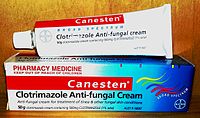
Photo from wikipedia
Invasive fungal infections remain a major cause of morbidity and mortality in the solid organ transplant population. NonAspergillus infections are of particular concern due to the reduced antifungal susceptibility of… Click to show full abstract
Invasive fungal infections remain a major cause of morbidity and mortality in the solid organ transplant population. NonAspergillus infections are of particular concern due to the reduced antifungal susceptibility of many of these fungi (Scedopsorium, Lomentospora, Fusarium, etc.), the difficulty in distinguishing these organisms from Aspergillus spp based on histopathology alone, and the higher associated mortality observed with these organisms. Current treatment options for these fungi are limited, and voriconazole is the most commonly recommended primary agent1,2 with combination therapy (terbinafine or an echinocandin) also recommended by some experts. Posaconazole, the new triazole isavuconazole, or liposomal formulations of amphotericin B are additional treatment options and may be of benefit in selected cases. The reduced antifungal efficacy of these agents in the treatment of refractory infections has prompted a search for new medications with novel mechanisms or with reduced toxicity—a number of which are in varying stages of clinical development.3 These antifungals include new formulations of existing compounds (SUBAitraconazole, amphotericin B cochleates), new glucan synthase inhibitors (CD101 and SCY078), and compounds targeting new pathways (GPIanchor inhibitors, fungal mitochondrial inhibitors, histone deacetylase inhibitors, heat shock protein inhibitors, dihydroorotate inhibitors, and others). Additionally, the field of infectious diseases seems likely to follow that of oncology and targeted immunomodulation will also become an essential adjunctive component of therapy. The ability to scrutinize an individual patient’s immune defect(s) rapidly and with precision in real time will undoubtedly precede the development and use of immunomodulation. While clinicians await the availability of these potentially more efficacious agents other means are often employed out of desperation in an attempt to improve patient outcomes. Antifungal doseescalation, combination therapy, and other adjunctive measures are often used in an attempt to control ongoing fungal infection. The use of therapeutic drug monitoring (TDM) has greatly assisted this practice and previous studies have observed improvements in antifungal efficacy with higher serum drug levels of voriconazole4 and posaconazole.5 However, specific toxicities have similarly been correlated with higher serum drug levels as might be expected. High voriconazole blood levels have been associated with neurologic toxicity, hepatic toxicity, photopsia, and others, while high posaconazole levels have only recently been described to exhibit potential toxicity. This newly described sideeffect causes the syndrome of apparent mineralocorticoid excess (hypertension, hypokalemia and alkalosis) and has been seen thus far only with posaconazole levels exceeding 4.0 μg/mL.6 From these reports is seems likely that attempts to “push” serum drug levels in the treatment of refractory infections almost certainly has a “ceiling” whereby the frequency of adverse effects mandates alternative therapeutic choices. In an attempt to circumvent these dosedependent adverse effects inhaled antifungal therapy has been evaluated in a number of previous studies. Inhaled therapy is of interest to minimize systemic toxicity and drugdrug interactions while improving drug delivery directly to the site of infection.7 This approach has been shown effective for antifungal prophylaxis in lung transplant recipients, but during the treatment of active infection inhaled therapy must be combined with a systemic agent to improve drug delivery to deeper tissues.8 The current report by Sole et al describes three patients with refractory Scedosporium infections who received adjunctive aerosolized posaconazole therapy with an improvement documented in two of three treated patients.9 This approach is the first use of aerosolized posaconazole to our knowledge and the authors are to be commended for their management and successful outcomes. Undoubtedly aggressive debridement of necrotic tissue via frequent bronchscopic evaluation assisted in improving outcomes for tracheobronchitis. We also believe it is important to note this approach is unlikely to be successful in those with more invasive forms of disease (such as within the lung parenchyma) when drug delivery via inhalation is more problematic, but does seem to be a useful adjuvant in selected cases involving the airway. Invasive fungal infections continue to increase in frequency and the growing number of immunosuppressed patients is unlikely to subside. While new antifungal agents are awaited, creative therapeutic approaches are often required. Inhaled therapy has many potential advantages and high local tissue concentrations may allow for fungicidal concentrations to be obtained. Evaluation of this tactic in animal models and human pharmacokinetic studies will greatly help refine this modality and determine its potential for use in a larger group of patients.
Journal Title: American Journal of Transplantation
Year Published: 2018
Link to full text (if available)
Share on Social Media: Sign Up to like & get
recommendations!